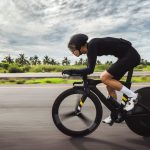When cycling, our body is connected to a bicycle at three places: foot-to-pedal (lower), buttocks-to-saddle (rear), and hands-to-handlebar (forward).
These connecting points are known as Contact Points. By moving these contact points into different positions relative to each other, the body’s center of gravity is being shifted around the bicycle and leads to a change in posture and pedaling motion efficiency.

For leisure cycling, where short distances and slow speeds are expected, folding and city bikes are designed to position the body’s center of gravity closer towards the pelvis (a.k.a. rear contact point). This puts more bodyweight onto the saddle and effectively lightens up the upper torso, reducing tension around the waist, shoulders, and hands.
This design yields a more forgiving setup, allowing cyclists to cycle comfortably for quite a distance even when they have less-than-perfect bike fitments. Also, maneuvering the bike at slow-to-almost-stopping speeds is easy and worry-free.
However, there are disadvantages that come with this setup. Firstly, the lack of weight loading at the handlebar (a.k.a. forward contact point), which means that while the bike is very agile to handle at slow speeds, it becomes wobbly and sometimes dangerously out-of-control at high speeds.
Then, with more bodyweight concentrated at the pelvis, sitting on a saddle across longer distances becomes uncomfortable even with a heavily padded saddle, simply due to an extended period of pressure at the buttocks. At this stage, you might start to yearn for a bike capable of longer distances and faster speeds, and this is when it’s worthwhile to consider road bicycles.

Contact points positioning for road bicycles is optimized towards achieving the fastest possible speed, with consideration not to sacrifice comfort. Contact points are spread further apart, stretching the limbs and lowering body lean angle, shifting the body’s center of gravity more towards the front to redistribute body weight more evenly across the three contact points, and effectively engaging body weight as a primary load to crank the pedals and propel the bike.
The extra weight being channeled onto the pedals (a.k.a. lower contact point) will increase efficiency in pedaling motion, increasing the power-to-weight ratio. However, there’s a limit to how much load our legs can sustain when cycling. When our legs fail to take up most of their share of body weight, the remainder is picked up by the forward contact point. When the forward weight becomes overbearing, discomfort at the lower back, shoulders, arms, and hands starts to appear, leading to numbness, stiffness, and pain. (for the sidebar bit– ‘tired’)

Balancing the bodyweight distribution across the three contact points now requires some careful and delicate touch. Slightly too much weight forward will make a fast-paced setup unsustainable for a longer journey. In contrast, slightly too much weight distributed rearward makes a comfortable ride but lacking in pedaling efficiency as more load is dispersed onto the saddle and not transmitted to the pedals. In terms of being delicate, the contact point adjustments should be in proximity of 2 or 3 millimeters.
The proper way to venture into road cycling should be in the sequence of getting a bike fit, getting educated on correct road biking techniques, increasing strength and stamina by cycling, and then further improving flexibility and core strength to squeeze out any further possible increment in performance. Of course, upgrading to better bikes does help but it is advisable that equipment upgrades should always be the last on the list, simply because no matter how great in design a bicycle can be, its performance will always be limited by the capability of the cyclist.




